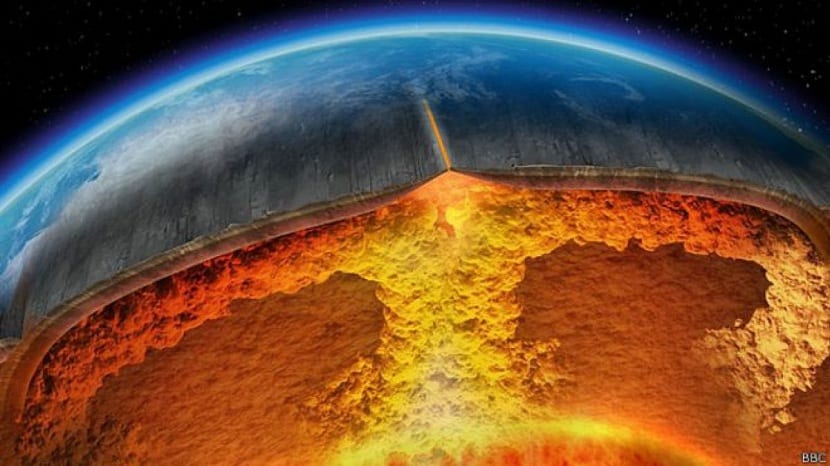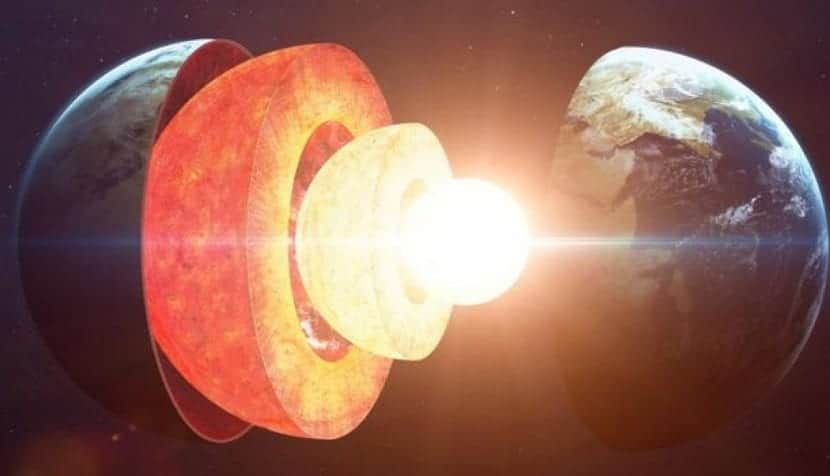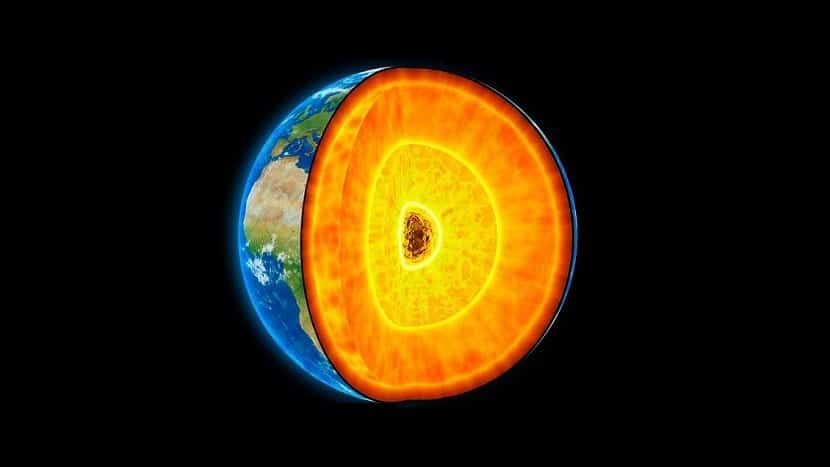
The nucleus is the last of the layers of the Earth. It is also known by the name of endosphere and it is a hot mass that is located in the very center of the interior of the planet. In its composition we can see both a solid core that is on the inside and an outer core that is liquid. Due to the convection currents that are generated by the differences in densities of materials in the Earth's core the terrestrial magnetic field.
In this article we are going to see a complete analysis of the core of the Earth and its importance.
Origin and formation

The core originated after the planet. When the Earth formed about 4.500 billion years agoIt was just a uniform ball of hot rock. Little by little it was suffering from a radioactive decomposition and with the heat that was given off from the formation of the planet caused it to heat up even more to the point of melting iron. This moment when the Earth reached these temperatures was called the iron catastrophe. The molten material that was in the rock and all the rocky material was having a greater movement and with more speed. As a result of this movement of less dense materials such as water, air and silicates, they made them become the Earth's mantle.
On the contrary, the denser and heavier materials such as iron, nickel and other heavy metals were able to pull the Earth's force of gravity toward the center. In this way, what we know as the first primitive terrestrial nucleus was formed. This process is known as that of planetary differentiation and it is where we begin to see that the Earth is made up of different layers with different characteristics and composition.
Composition of the Earth's core

As we know, the Earth crust and the mantle are rich in minerals. However, the earth's core is composed mostly of iron and nickel metals. We also find materials that dissolve in iron called siderophiles. These elements are not at all common in the crust and, for this reason, they have been called precious metals. In these precious metals we find cobalt, gold and platinum.
Another key element found in the core is sulfur. 90% of all sulfur on Earth is in the core. The core is known to be the hottest part of the entire planet. Internal structures increase in temperature as we increase in depth. However, given the more than 6.000 kilometers that separate us from the Earth's surface to the Earth's core, it is quite difficult to know at the temperature at which this molten iron and nickel center is. The temperatures are not always the same. They fluctuate depending on the pressure, rotation of the Earth and the composition of the elements that make up the nucleus.
Since the convection currents are causing the materials to be moving, there are some materials that enter "new" to the core while others leave again and are no longer molten. This is due to the proximity or distance of the materials from the center and their very high melting point.
Studies generally say that the temperature of the Earth's core It goes from 4000 degrees Celsius to 6000 degrees, approximately.
Key features

Among its characteristics we see that the materials that contribute to the heat in the core is the decomposition of radioactive materials. Radioactive materials give off a large amount of energy when they break down. That energy is transformed into heat when it is released. The leftover heat from the planet's formation is still there, warming the core. Another heat contributor is the heat that is released into the liquid outer core and solidifies at its limit when it encounters the inner core. Remember that the outer core of our planet is liquid and the inner core is solid.
Every time we descend a depth of 1 km from the earth's surface, the temperature increases by about 25 degrees more. This means that the geothermal gradient is approximately 25 degrees. The limit that separates the inner nucleus from the outer one is known as the Bullen discontinuity. The outermost part of the core is about 3.000 km under our feet. But worst of all, the center point of the Earth's core is about 6.000 km deep.
To give you an idea of how little we have pierced our planet, that the deepest hole that has been made has only descended 12,3 km. It is as if from an apple, we had only delved into the thin skin (and not even that).
Core layers

Let's take a closer look at the core layers.
External nucleus
It is about 2.200 km thick and is composed of iron and nickel in a liquid state. Its temperature is around 5000 degrees Celsius. The metal in liquid state in this layer has a very low viscosity, so it can be easily deformed and malleable. In this case, there are quite violent convection currents that cause the Earth's magnetic field to form.
The hottest part of the outer core is at the Bullen discontinuity.
Inner core
It is a very hot and dense ball that is composed mainly of iron. The temperature reaches about 5200 degrees Celsius. Here the pressure is almost 3,6 million atmosphere.
The temperature of the inner core is well above the melting point of iron. However, it is in a solid state. This is because, unlike the outer core, the atmospheric pressure is much higher and that prevents it from melting.
With this information they will be able to know more about the core of the Earth and its characteristics.